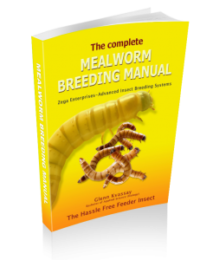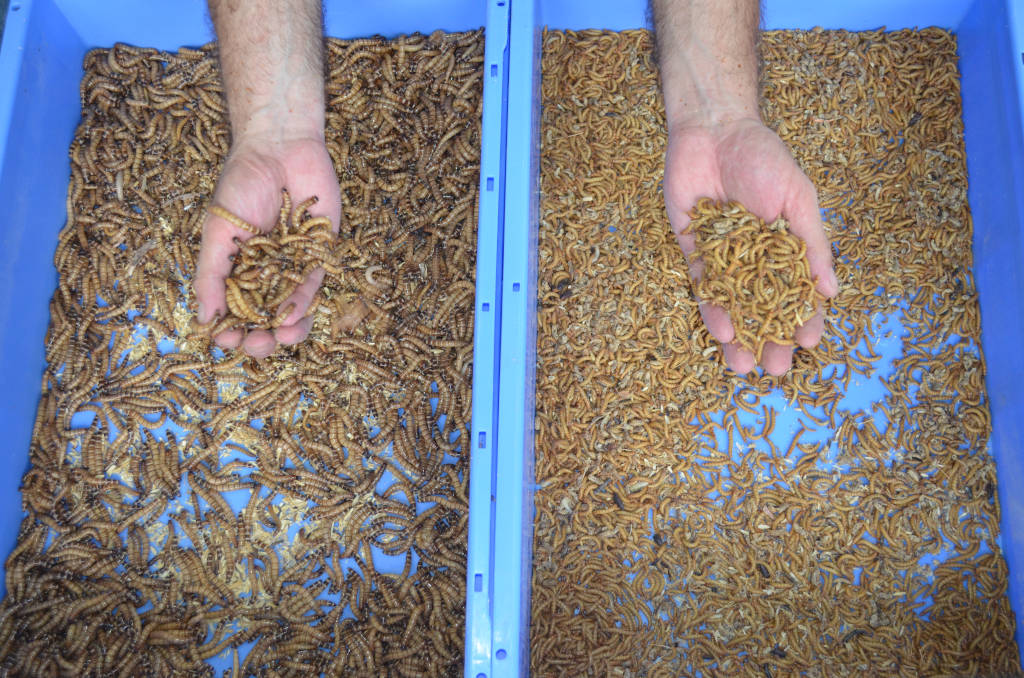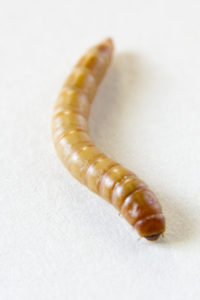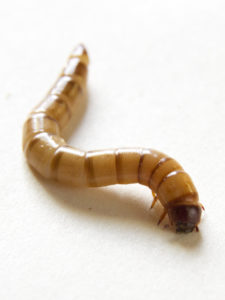Should I breed a cool temperate species such as the Yellow mealworm (Tenebrio molitor) or the tropical Giant Mealorm (Zophobas Morio) ?. This is probably the most important question which will determine whether you succeed or fail breeding Mealworms. Yet most people give little or no thought to the matter and just assume they should breed yellow mealworms.
Below are some learnings we will share with you…but in a nut shell if you live in a warm temperate or tropical environment you may be better breeding giant mealworms….and if you live in a cool temperate environment you may be better breeding the yellow mealworm. If you have climate control you can breed either species…although you probably will probably have more issues with yellow mealworms.
Most people think that giant mealworms are too big for what they need….however you can easily harvest them at a younger stage making them the same size as normal mealworms. Their are a lot of other advantages that giant mealwoms have over yellow mealworms which we discuss below:
Our Learnings
- For many years we bred yellow mealworms in a tropical or warm temperate environment and struggled with consistency and volume in Summer (in our busy period).
- As soon as we bred giant mealworms (tropical species) both consistency and volume increased significantly in our busy periods.
- As soon as we converted to climate control with air conditioning the consistency of yellow mealworms significantly increased. For example when you introduced air conditioning virtually all the yellow mealworm pupae which had been sitting dormant for many weeks instantly burst into beetles overnight. Yet we saw no change in the giant pupa trays. It was obvious that temperature was the trigger for yellow mealworms.
Pros and Cons of Each Species
Pros
- Are the most popular and common species people want to buy
- Are better suited to cool temperate environments (with heat in winter) with better consistency and volume than giant mealworms.
- Are a good size for most common reptile and wildlife species.
- With the right climate control are productive.
Cons
- Are not well suited to warm temperate or tropical environments in summer without climate control. Beetles may die and pupae may either die or lie dormant for long periods.
- Are more prone to pests such as moths, mites etc than giant mealworms.
- Worms go to pupae and beetle quickly. Managing stock and excess stock management can be difficult.
- For productive growth you may need to install air conditioner in warm to tropical environments which adds to expenses.
Pros
- Have higher consistency and volume than yellow mealworms in warm temperate and tropical environments with no climate control.
- High production rates also apply to cool temperate environments with addition of heat
- As they are more carnivorous they will eat many pest species such as moths, mites etc and this makes them less prone to pest species which is a big issue for many operations.
- Worms wont go to pupae until separated. This greatly increases their shelf life and the ability to manage stock.
Cons
- Are not as popular with many wildlife rescue groups and they may need convincing or educating to convert.
- Giants mealworms will start to die when temperatures fall below 12 degres, whereas yellow mealworms wont die but will remain dormant. Yellow mealworms may not die but their production rates will stagnate unless heat is added.
- Will need heating in Cool temperate environments in winter, however heating would have probably been required for yellow mealworms (see above). Heating is relatively cheap compared to cost of buying mealworms (see heating section)
- There is additional maintenance separating out the pupa into individual cells and hand picking out the beetles. This does not take as long as you may think. It would take less than 1minute maintenance per day for 60 pupa cells.
Making a Species Work Better
For many people the species they choose comes down to what the market Wants. Lets face it there is no point breeding giant mealworms if all your clients want to buy yellow mealworms. Before expanding your operations find out what people actually want.
Another factor to consider is that adding heat is relatively easy and cheap (heat mats or heaters) whilst cooling is often difficult and more expensive (air conditioning)….although their are a lot of cheap portable options that you can get for just a few hundred dollars second hand. Given heat is easier to achieve than cooling, for the hobbyist giant mealworms are a good option to achieve good growths year round in cool and tropical environments.
Below are some tips to make things work:
- When breeding yellow mealworms in warm temperate or tropical area use air conditioning where possible.
- When breeding giant mealworms use heat hats/heaters/reverse cycle air conditioners to heat.
- Consider doing a presentation to a wildlife group to educate them on switching to a different species.




